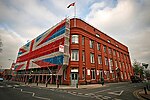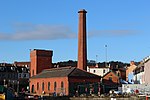Tobacco Factory

The Tobacco Factory is the last remaining part of the old W. D. & H. O. Wills tobacco factory site on Raleigh Road, Southville, Bristol. It was saved from demolition by the architect and former mayor of the city George Ferguson and through his vision has become a model of urban regeneration. It is now a multi-use building which houses animation and performing arts school, loft-style apartments, a café bar, offices and a theatre. Inspired by the Manchester Independents campaign, George Ferguson decided to launch a Bristol-based campaign from the Tobacco Factory, the purpose is to encourage the support and patronage of independent outlets and businesses to help redress the balance that has swung strongly in favour of the multiples at the expense of local character and enterprise. Business at the Tobacco Factory epitomises this, with home grown enterprises, such as Fanatic Design, CLIK.
Excerpt from the Wikipedia article Tobacco Factory (License: CC BY-SA 3.0, Authors, Images).Tobacco Factory
Raleigh Road, Bristol Southville
Geographical coordinates (GPS) Address External links Nearby Places Show on map
Geographical coordinates (GPS)
| Latitude | Longitude |
|---|---|
| N 51.4423 ° | E -2.6135 ° |
Address
Raleigh Road 278
BS3 1TF Bristol, Southville
England, United Kingdom
Open on Google Maps









